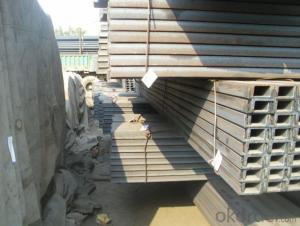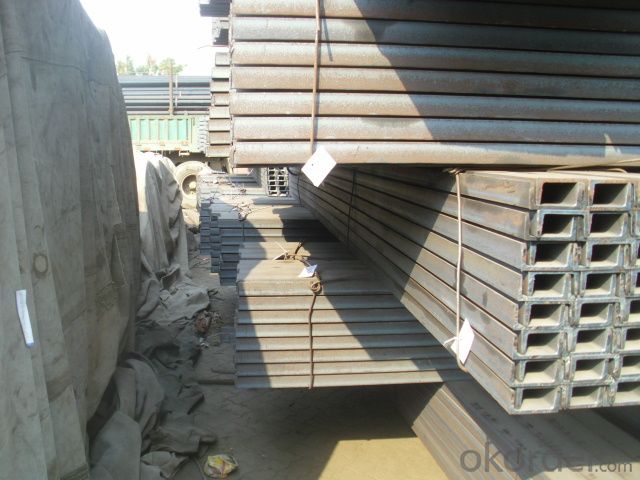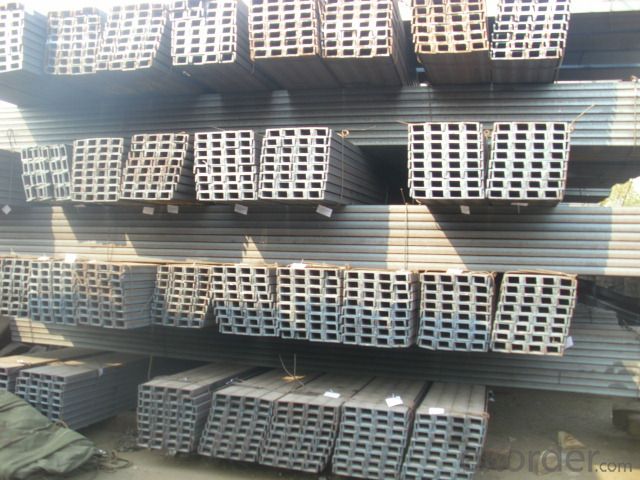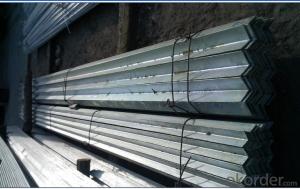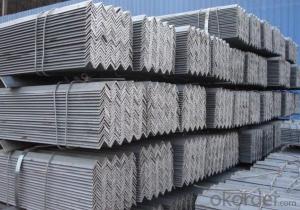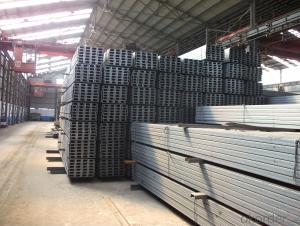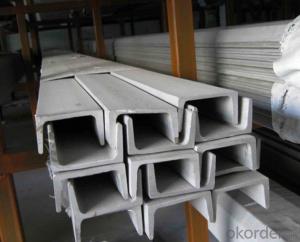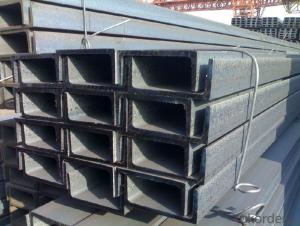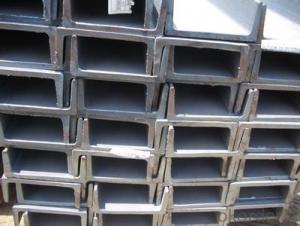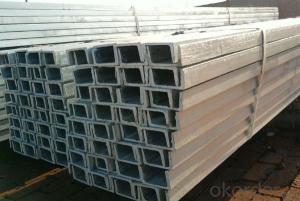GB ALLOY HOT ROLLED U CHANNEL 100*50 6M
- Loading Port:
- Qingdao
- Payment Terms:
- TT OR LC
- Min Order Qty:
- 50 m.t.
- Supply Capability:
- 10000 m.t./month
OKorder Service Pledge
OKorder Financial Service
You Might Also Like
Product Description:
Specifications of Steel U Channel:
Standard Applied: GB Standard, EN Standard(UPN), JIS Standard
Sizes: 50mm to 300mm
Material Grade: Q235B, Q345B, S235JR, SS400, ASTM A36
As shown in the figure:
JIS U CHANNEL | Standard h | Sectional b | Dimension s | t | Mass: Kg/m |
(mm) | (mm) | (mm) | (mm) | ||
50x25 | 50 | 25 | 3.0 | 6.00 | 2.37 |
75X40 | 75 | 40 | 3.8 | 7.00 | 5.30 |
75X40 | 75 | 40 | 4.0 | 7.00 | 5.60 |
75X40 | 75 | 40 | 4.5 | 7.00 | 5.85 |
75X40 | 75 | 40 | 5.0 | 7.00 | 6.92 |
100X50 | 100 | 50 | 3.8 | 6.00 | 7.30 |
100X50 | 100 | 50 | 4.2 | 6.00 | 8.03 |
100X50 | 100 | 50 | 4.5 | 7.50 | 8.97 |
100X50 | 100 | 50 | 5.0 | 7.50 | 9.36 |
125X65 | 125 | 65 | 5.2 | 6.80 | 11.66 |
125X65 | 125 | 65 | 5.3 | 6.80 | 12.17 |
125X65 | 125 | 65 | 5.5 | 8.00 | 12.91 |
125X65 | 125 | 65 | 6.0 | 8.00 | 13.40 |
150x75 | 150 | 75 | 5.5 | 7.30 | 14.66 |
150x75 | 150 | 75 | 5.7 | 10.00 | 16.71 |
150x75 | 150 | 75 | 6.0 | 10.00 | 17.90 |
150x75 | 150 | 75 | 6.5 | 10.00 | 18.60 |
Note: We are able to supply other dimensions and sizes, which depends on the customer's requirements for the quantity.
Chemical Composition of Q235B Steel U Channel:
Alloy No | Grade | Element(%) | ||||
C | Mn | S | P | Si | ||
Q235 | B | 0.12-0.20 | 0.3-0.7 | ≦0.045 | ≦0.045 | ≦0.3 |
Physical Properties of Q235B Steel U Channel:
Grade | Yielding Strength Point(Mpa) | ||||
Q235B | Thickness(mm) | ||||
≦16 | >16-40 | >40-60 | >60-100 | ||
≧235 | ≧225 | ≧215 | ≧205 | ||
Tensile Strength(Mpa) | Elongation After Fracture(%) | ||||
Thickness(mm) | |||||
≦16 | >16-40 | >40-60 | >60-100 | ||
375-500 | ≧26 | ≧25 | ≧24 | ≧23 | |
Usage/Application of Steel U Channel:
The steel u channel can be applied to construction of warehouses, workshops, sport stadiums and car parks etc. In details, the steel u channel belongs to carbon structural steel which is applied to in the field of construction and machinery. The steel u channel is usually used for arch-itechtural structure, and they could be welded in order to support or hang a vari-ety of facilities. They are also usually used in combination with I beam. Generally,the steel u channel must possess perfect welding property, riveting property and mechanical property and so on.
Package & Delivery: Steel U Channel
The steel u channel will be packed in bundle with steel wire at each end of every bundle and color marking in order to help the customer to recognize his goods more easily at sight.
And steel u channel could be loaded into 20ft or 40ft container, or by bulk cargo. If the weight of each bundle reaches less than 3.5 mt, the loading by break bulk cargo should be choosed. When the weight of each bundle reaches less than 3mt, the loading by container should be choosed.
As for the transportaion from mill to loading port, the truck will be usually used. And the maximum quantity for each truck is 40mt.
All in all, we could do in accordance with customer's request
Production Flow of Steel U Channel:
1.The steel billet shall be heated in the high temperature furnace.
2. The heated steel billet shall be rolled five to nine times with the aim of shaping the general figure of steel u channel.
3. The rolled steel u channel should be put onto the cooling bed to make the temperature low.
4. The steel u channel should be straighted on the straightener.
5. The straighted steel u channel will be cut into meters by saw, as per customer's requirements.
- Q: Can steel angles be used in storage rack systems?
- Yes, steel angles can be used in storage rack systems. Steel angles provide strength and stability, making them suitable for supporting heavy loads in storage racks. They can be used to create the framework and support beams in the rack system, ensuring durability and safety.
- Q: How do you determine the required angle size for a specific application?
- Several factors must be taken into consideration in order to determine the necessary angle size for a specific application. First and foremost, it is crucial to understand the purpose or function of the application. Different applications may require different angle sizes depending on the desired outcome. For instance, if the application involves cutting or shaping materials, the angle size must be determined based on the desired level of precision or detail. Secondly, the materials used in the application must be carefully considered. Some materials may be more brittle or prone to damage, while others may be more flexible. The chosen angle size should take into account the properties of the materials and minimize the risk of damage or failure. Thirdly, the specific conditions or environment in which the application will be used should be taken into account. Factors such as temperature, pressure, or moisture levels can impact the performance of the application and influence the required angle size. It is essential to select an angle size that can withstand the expected conditions and provide optimal functionality. Furthermore, consulting industry standards or guidelines that may exist for the specific application can be beneficial. These standards often provide recommended angle sizes based on best practices and past experiences. They serve as a useful reference point in determining the required angle size. Lastly, it may be necessary to conduct testing or simulations to verify the selected angle size. By creating prototypes or using computer-aided design (CAD) software, one can evaluate the performance and effectiveness of different angle sizes before making a final decision. In conclusion, determining the necessary angle size for a specific application involves considering the purpose, materials, environmental conditions, industry standards, and potentially conducting testing or simulations. By analyzing these factors, one can make an informed decision and select the most suitable angle size for the application.
- Q: Are steel angles available in different grades?
- Different grades of steel angles are indeed available. Carbon steel is the commonly used material for steel angles, and it comes in various grades like A36, A572, and A588. These grades possess distinct chemical compositions and mechanical properties, rendering them suitable for diverse applications. Furthermore, stainless steel angles are also obtainable in grades such as 304 and 316, which exhibit exceptional corrosion resistance characteristics. Selecting the appropriate grade of steel angle depends on specific project requirements, encompassing strength, longevity, and resistance to corrosion.
- Q: What are the different types of connections used for steel angles in structural applications?
- There are several types of connections that are commonly used for steel angles in structural applications. These connections are crucial for ensuring the stability and strength of the overall structure. 1. Welded connections: Welding is one of the most common methods used to connect steel angles. It involves melting the edges of the steel angles together to form a strong bond. Welded connections are typically used in applications where high strength and rigidity are required. 2. Bolted connections: Bolted connections involve using bolts and nuts to secure the steel angles together. This type of connection provides flexibility as it allows for disassembly and reassembly if needed. Bolted connections are often used in situations where ease of installation and maintenance is important. 3. Riveted connections: Riveting is a traditional method of joining steel angles. It involves inserting a rivet through holes in the steel angles and then flaring the ends to secure them in place. Riveted connections are known for their durability and resistance to corrosion. However, they are less commonly used today due to the time-consuming installation process. 4. Clip connections: Clip connections involve using metal clips or brackets to attach the steel angles. These clips are typically welded or bolted to the steel angles and provide a quick and efficient method of connection. Clip connections are often used in applications where speed and ease of installation are important factors. 5. Gusset plate connections: Gusset plates are steel plates that are used to connect steel angles at their intersection points. They are typically welded or bolted to the angles and provide additional strength and stability to the connection. Gusset plate connections are commonly used in situations where larger forces and moments need to be transferred. Each type of connection has its own advantages and disadvantages, and the choice of connection method depends on several factors including the structural requirements, loadings, and the specific application. It is important to consider the design and engineering specifications to ensure that the chosen connection method is suitable for the intended use in structural applications.
- Q: Can steel angles be used for sign supports?
- Yes, steel angles can be used for sign supports. Steel angles provide strength and stability, making them suitable for supporting signs of various sizes and weights. They are commonly used in the construction industry for a variety of structural applications, including sign supports. The angles can be easily welded or bolted together to create a sturdy framework for the signs. Additionally, steel angles are durable and resistant to environmental factors such as wind, rain, and corrosion, ensuring the longevity of the sign supports.
- Q: What is the cost of steel angles compared to other structural materials?
- The cost of steel angles compared to other structural materials can vary depending on factors such as the specific type of material, market conditions, and quantity needed. However, generally speaking, steel angles tend to be a cost-effective choice for structural applications due to their durability, strength, and versatility.
- Q: What are the safety considerations when working with steel angles?
- When working with steel angles, it is crucial to prioritize safety. Some key safety considerations include wearing appropriate personal protective equipment (PPE) such as gloves, safety glasses, and steel-toed boots to protect against potential injuries. Additionally, it is important to handle steel angles with care and use proper lifting techniques to avoid strain or muscle injuries. Adequate training and knowledge of the equipment being used, such as angle grinders or welding tools, is essential to prevent accidents. Finally, maintaining a clean and organized work area can help minimize tripping hazards and ensure a safer working environment.
- Q: Are steel angles available in custom sizes?
- Yes, steel angles are available in custom sizes.
- Q: What is the process of hot rolling steel angles?
- The process of hot rolling steel angles involves a series of steps that transform raw materials into finished steel angles with specific dimensions and properties. Firstly, the raw material, which is typically a billet or a continuous casting, is heated to a temperature above its recrystallization point. This makes the steel more malleable and easier to shape. The heated billet is then fed into a rolling mill, where it passes through a series of rollers. These rollers apply pressure to the billet, causing it to deform and take the shape of an angle. The angle is determined by the shape of the rollers, which have a groove or profile that matches the desired angle dimensions. As the billet passes through the rolling mill, it undergoes a process called plastic deformation. This involves the elongation and reduction of its cross-sectional area, resulting in a longer and thinner shape. The angle's flanges, which are the vertical sides, and the web, which is the horizontal section connecting the flanges, are formed during this deformation. To maintain the desired shape and dimensions, the steel angle may pass through multiple sets of rollers, each applying pressure and further shaping the angle. This continuous rolling process ensures consistent dimensions and smooth surfaces. Once the hot rolling process is complete, the steel angles are cooled and straightened. This is typically done using water or air cooling methods. Cooling the steel rapidly helps to harden and strengthen it, while straightening ensures that the angles are free from any bends or twists. After cooling and straightening, the steel angles may undergo additional processes such as cutting to the desired length, surface treatment such as painting or galvanizing, and quality control inspections to ensure they meet the required specifications. Overall, the hot rolling process for steel angles involves heating the raw material, passing it through rolling mills to shape and deform it, cooling and straightening the angles, and finally finishing them to meet the desired specifications. This process results in high-quality steel angles that are widely used in construction, manufacturing, and various other industries.
- Q: Are steel angles suitable for mezzanine floors?
- Yes, steel angles are suitable for mezzanine floors. Steel angles provide excellent structural support and stability, making them ideal for creating elevated platforms like mezzanine floors. They are strong, durable, and can withstand heavy loads, making them a reliable choice for constructing mezzanine flooring systems.
Send your message to us
GB ALLOY HOT ROLLED U CHANNEL 100*50 6M
- Loading Port:
- Qingdao
- Payment Terms:
- TT OR LC
- Min Order Qty:
- 50 m.t.
- Supply Capability:
- 10000 m.t./month
OKorder Service Pledge
OKorder Financial Service
Similar products
Hot products
Hot Searches
Related keywords
